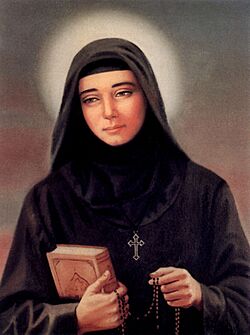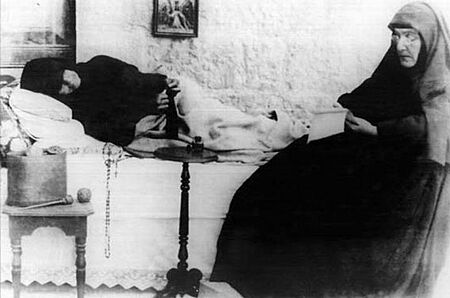Rafqa Pietra Choboq Ar-Rayès facts for kids
Quick facts for kids SaintRafqa (Rafka) O.L.M. |
|
|---|---|
 |
|
| Monastic | |
| Born | 29 June 1832 Himlaya, Mount Lebanon Emirate |
| Died | 23 March 1914 (aged 81) Monastery of Saint Joseph, Jrebta, Lebanon |
| Venerated in | Maronite Church Roman Catholic Church Eastern Catholic Churches |
| Beatified | November 16, 1985 by Pope John Paul II |
| Canonized | June 10, 2001, Saint Peter's Basilica, Vatican City by Pope John Paul II |
| Feast | March 23 |
Saint Rafqa (born Boutrossieh Chobok) was a Lebanese nun. She lived from 1832 to 1914. She is also known as Saint Rebecca.
Rafqa was a member of the Maronite Church. She was made a saint by Pope John Paul II in 2001. Many people see her as a helper for sick people and those who have lost their parents.
| Top - 0-9 A B C D E F G H I J K L M N O P Q R S T U V W X Y Z |
Early Life and Becoming a Nun
Rafqa was born in Himlaya, Lebanon, on June 29, 1832. Her full name was Boutrossieh Chobok. She was the only child of Saber Mourad El Rayess and Rafqa Gemayel. She was named Boutrossieh after Saint Peter.
When she was seven, her mother died. At age 11, she worked as a helper in Damascus for four years. She returned home in 1847. Her father had remarried.
A Difficult Choice
When Boutrossieh was 14, her family wanted her to marry. Her stepmother wanted her to marry her brother. Her aunt wanted her to marry her son. Boutrossieh did not want to marry either. This caused many arguments in her family.
One day, she was coming home from the fountain. She heard her family arguing. She asked God for help. She then decided to become a nun. She went straight to the Convent of Our Lady of Liberation in Bikfaya. Her father and stepmother tried to bring her home. But she refused to leave. They went home sad and never saw her again.
Joining the Mariamette Sisters
Boutrossieh's relative, Joseph Gemayel, started a new group for women. It offered education and religious teaching. Boutrossieh was one of the first four young women to join. This was in 1853, when she was 21. The group was called the Daughters of Mary of the Immaculate Conception. People often called them "Mariamettes."
In 1860, Sister Rafqa was sent to help a mission in Deir-el-Qamar. During this time, there were terrible conflicts. Many people were killed. Sister Rafqa saved a child's life. She hid him in her nun's clothes from soldiers. These events deeply affected her.
On March 19, 1861, she officially joined the Mariamettes. She took her first vows on March 19, 1862. She was 30 years old. Her first job was in the kitchen at a Jesuit school. She worked there for seven years. She also taught workers and studied in her free time.
Later, Sister Rafqa taught in Byblos. Then she went to Ma'ad to start a new school.
Becoming a Cloistered Nun
In 1871, the Mariamettes group joined with another. Nuns could choose to join the new group or a different one. Rafqa decided to become a cloistered nun. This meant she would live a life of prayer within a monastery.
She prayed in the Church of St. George. She decided to join the Lebanese Maronite Order. This is a monastic order founded in 1695. She told Antoun Issa, a local citizen, about her choice. He offered to pay the money needed for her to join.
That night, Rafqa had a dream. She saw three men. One told her to join the Baladita Order. She woke up very happy. She went to Antoun Issa and told him. He said the men were likely Saint Anthony, Saint George, and a monk from the order. Rafqa then left for the Monastery of St. Simon.
Life as a Maronite Nun
Monastery of St. Simon
On July 12, 1871, Rafqa began her training at the new monastery. She was 39 years old. On August 25, 1873, she made her final vows. She promised to live a life of poverty, purity, and obedience. She took the new name Rafqa, which was her mother's name. It means Rebecca.
The Monastery of St. Simon was high in the mountains. Winters were very cold. The nuns followed a strict daily routine. They spent their days praying and working. They grew vegetables and grains. They also raised silkworms and sewed clothes for churches. Rafqa lived at this monastery until 1897.
Her Illness
In 1885, Rafqa decided not to go for a walk with the other nuns. She went to the church to pray. She felt very healthy and had never been sick. She prayed to God, asking why she had never experienced sickness.
The next night, she felt a terrible pain in her eyes. She became blind and paralyzed. She believed this was an answer to her prayer. She did not complain.
Her superior sent Rafqa to Tripoli for medical help. Doctors could not do anything. An American doctor suggested removing her eye. Before the operation, Rafqa refused pain medicine. The doctor removed her eye. Rafqa did not cry out. She only said, "in communion with Christ's Passion." The pain then moved to her other eye. Nothing could be done to save it.
Rafqa slowly became completely blind. She had constant, strong pain in her head. But she saw this as a way to share in Jesus' suffering. She did not let the pain stop her. She continued to spin wool and cotton. She knitted socks for the other sisters. She also joined in group prayers.
Because of the harsh winters, Rafqa was allowed to spend the coldest months on the coast. But she wanted to follow her order's rules strictly. So she asked to go to the Monastery of St. Elias.
Monastery of St. Joseph
In 1897, the Lebanese Maronite Order built a new monastery. It was called St. Joseph al Dahr in Jrabta. Rafqa was one of six nuns sent to this new place.
By 1899, she was fully blind and paralyzed. She had to stay in bed. She spent her time knitting socks.
Near the end of her life, a sister asked if she wished to see again. Rafqa prayed to see for just one hour. Her prayer was answered.
On March 23, 1914, she died. She was buried in the monastery cemetery. Later, her body was moved to the monastery chapel.
Becoming a Saint

After her death, people believed Rafqa had performed miracles. Investigations into her life began in 1929. She was then called a "Servant of God."
On June 9, 1984, Pope John Paul II approved a miracle. A woman named Elizabeth Ennakl was cured of cancer in 1938. This happened after she visited Rafqa's tomb.
On November 16, 1985, Pope John Paul II declared Rafqa "Blessed." This is the step before becoming a saint. Finally, on June 10, 2001, he officially made her a saint. This was done in a special ceremony at the Vatican.


